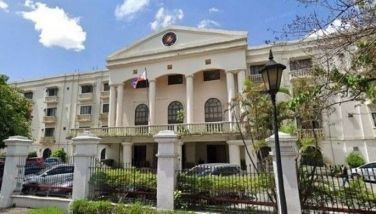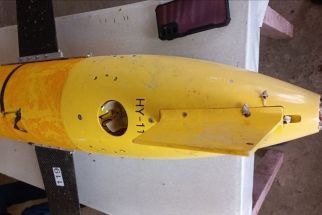RP’s location makes it prone to disasters
January 2, 2004 | 12:00am
The Philippines is prone to natural disasters because of its geographical location, an officer of the Philippine National Red Cross (PNRC) said.
"We are in the ring of fire. We happen to be situated between two tectonic plates — the Eurasian and the Pacific... When these two plates move, the land also moves and it becomes an earthquake," said James Sian, programs manager of the PNRC’s Disaster Management Service.
Magma underneath the earth also finds its way out through the plates, forming volcanoes. Of the almost 200 volcanoes in the Philippines, 21 are considered active.
"The only province in the country that is rarely hit by an earthquake is Palawan. That’s because it is situated right on top of the Eurasian plate," he told The STAR.
Sian noted that the Philippines is also prone to typhoons because it is near the Pacific Ocean.
"Just like the Atlantic Ocean, the Pacific Ocean is a breeding ground for typhoons because it has a large body of water. The temperature there rises and falls when the earth rotates on its axis, forming tornadoes and typhoons," he added.
The country’s long coastline, which stretches 17,461 kilometers or double that of the continental United States, also exposes coastal villages to typhoons and tsunamis.
Annually, the PNRC estimates that the Philippines loses at least P20 billion in infrastructure and crops because of natural disasters, particularly typhoons.
Among the strong typhoons that hit the country last year were "Egay" in June, "Weng" in November and "Harurot" in July.
The death toll from Harurot was 17 and damage to crops was placed at P10 million in Northern Benguet alone.
Disasters can be mitigated if people are trained to recognize danger.
This was the conclusion made by PNRC in the wake of the landslide in Southern Leyte, which left around 200 people killed or declared missing.
The tragedy capped the estimated 40 disasters that struck the country in 2003.
Thousands of families lost their homes and loved ones when tons of soil and debris crashed down on the towns of Liloan, San Francisco, Pintuyan, San Ricardo, Maasin and Malitbog in Southern Leyte two weeks ago.
Deforestation was seen as the culprit in the tragedy since there are reportedly no more trees in the area, whose roots can hold the soil.
The Department of Social Welfare and Development (DSWD) had also recorded two earthquakes, 15 flashfloods, five tornadoes, ten typhoons and six landslides for the year.
DSWD Secretary Corazon Soliman said that much of the natural disasters in the country are aggravated because the "people do not realize or fail to appreciate the risk they face when they are in a danger zone."
She cited, for instance, the insistence of some people to live near creeks, despite the risk of being swept away during flash floods, because their livelihood is there.
"They choose to live there mainly because they believe it is better to earn and take the risk," she added.
Soliman also said that some supposedly natural disasters are actually man-made "because of our inability to take care of the environment."
To cushion the impact of disasters, Soliman wanted strong disaster coordinating councils to be put in place in all provinces and for Filipinos to learn to love the environment and learn to assess danger in their surroundings.
Like the DSWD, the PNRC wanted to change the concept of disaster management.
Sian maintained that Filipinos need to prepare for disasters even before they happen so that the effects can be mitigated.
This is the reason why as early as 1995, the PNRC launched the Integrated Community-based Disaster Planning Program (ICDPP) in Southern Leyte, Surigao del Norte, Benguet, Payatas in Quezon City and Palawan through the assistance of the Danish Red Cross.
The program had eventually been implemented in Quirino, Quezon, Camarines Sur and Antique and the PNRC is hoping to replicate it in other provinces.
Under the program, PNRC educates barangay leaders about "pre-disaster" measures or measures that should be undertaken before the actual disasters strike. These leaders are tasked to pass the knowledge to the community folk.
Sian added that the priority right now is to train the people to recognize signs of impending disasters. He said that under the old disaster management system, people are merely taught to rescue people and to rehabilitate disaster-affected areas.
However, under the new program, people do not have to wait for disasters to happen before doing something since the program is focused on responsiveness.
"Instead of teaching the public how to react to disasters, we want them to know if disaster is likely to happen. This can be done if they know the factors that usually trigger disasters. With this program, we hope that the impact of disasters can be mitigated," Sian added.
"We are in the ring of fire. We happen to be situated between two tectonic plates — the Eurasian and the Pacific... When these two plates move, the land also moves and it becomes an earthquake," said James Sian, programs manager of the PNRC’s Disaster Management Service.
Magma underneath the earth also finds its way out through the plates, forming volcanoes. Of the almost 200 volcanoes in the Philippines, 21 are considered active.
"The only province in the country that is rarely hit by an earthquake is Palawan. That’s because it is situated right on top of the Eurasian plate," he told The STAR.
Sian noted that the Philippines is also prone to typhoons because it is near the Pacific Ocean.
"Just like the Atlantic Ocean, the Pacific Ocean is a breeding ground for typhoons because it has a large body of water. The temperature there rises and falls when the earth rotates on its axis, forming tornadoes and typhoons," he added.
The country’s long coastline, which stretches 17,461 kilometers or double that of the continental United States, also exposes coastal villages to typhoons and tsunamis.
Annually, the PNRC estimates that the Philippines loses at least P20 billion in infrastructure and crops because of natural disasters, particularly typhoons.
Among the strong typhoons that hit the country last year were "Egay" in June, "Weng" in November and "Harurot" in July.
The death toll from Harurot was 17 and damage to crops was placed at P10 million in Northern Benguet alone.
This was the conclusion made by PNRC in the wake of the landslide in Southern Leyte, which left around 200 people killed or declared missing.
The tragedy capped the estimated 40 disasters that struck the country in 2003.
Thousands of families lost their homes and loved ones when tons of soil and debris crashed down on the towns of Liloan, San Francisco, Pintuyan, San Ricardo, Maasin and Malitbog in Southern Leyte two weeks ago.
Deforestation was seen as the culprit in the tragedy since there are reportedly no more trees in the area, whose roots can hold the soil.
The Department of Social Welfare and Development (DSWD) had also recorded two earthquakes, 15 flashfloods, five tornadoes, ten typhoons and six landslides for the year.
DSWD Secretary Corazon Soliman said that much of the natural disasters in the country are aggravated because the "people do not realize or fail to appreciate the risk they face when they are in a danger zone."
She cited, for instance, the insistence of some people to live near creeks, despite the risk of being swept away during flash floods, because their livelihood is there.
"They choose to live there mainly because they believe it is better to earn and take the risk," she added.
Soliman also said that some supposedly natural disasters are actually man-made "because of our inability to take care of the environment."
To cushion the impact of disasters, Soliman wanted strong disaster coordinating councils to be put in place in all provinces and for Filipinos to learn to love the environment and learn to assess danger in their surroundings.
Like the DSWD, the PNRC wanted to change the concept of disaster management.
Sian maintained that Filipinos need to prepare for disasters even before they happen so that the effects can be mitigated.
This is the reason why as early as 1995, the PNRC launched the Integrated Community-based Disaster Planning Program (ICDPP) in Southern Leyte, Surigao del Norte, Benguet, Payatas in Quezon City and Palawan through the assistance of the Danish Red Cross.
The program had eventually been implemented in Quirino, Quezon, Camarines Sur and Antique and the PNRC is hoping to replicate it in other provinces.
Under the program, PNRC educates barangay leaders about "pre-disaster" measures or measures that should be undertaken before the actual disasters strike. These leaders are tasked to pass the knowledge to the community folk.
Sian added that the priority right now is to train the people to recognize signs of impending disasters. He said that under the old disaster management system, people are merely taught to rescue people and to rehabilitate disaster-affected areas.
However, under the new program, people do not have to wait for disasters to happen before doing something since the program is focused on responsiveness.
"Instead of teaching the public how to react to disasters, we want them to know if disaster is likely to happen. This can be done if they know the factors that usually trigger disasters. With this program, we hope that the impact of disasters can be mitigated," Sian added.
BrandSpace Articles
<
>
- Latest
- Trending
Trending
Latest
Trending
Latest
Recommended































